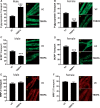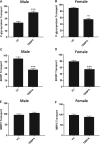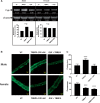Tetrabromobisphenol A (TBBPA) Alters ABC Transport at the Blood-Brain Barrier
- PMID: 30830211
- PMCID: PMC6542337
- DOI: 10.1093/toxsci/kfz059
Tetrabromobisphenol A (TBBPA) Alters ABC Transport at the Blood-Brain Barrier
Abstract
Tetrabromobisphenol A (TBBPA, CAS No. 79-94-7) is a brominated flame retardant used in 90% of epoxy coated circuit boards. Exposures to TBBPA can induce neurotoxicity and disrupt MAPK, estrogen, thyroid, and PPAR-associated signaling pathways. Because these pathways also regulate transporters of the central nervous system barriers, we sought to determine the effect of TBBPA on the expression and activity of 3 ATP binding cassette (ABC) transporters of the blood-brain barrier (BBB). Using a confocal based assay, we measured the ex vivo and in vivo effects of TBBPA on P-glycoprotein (P-gp), breast cancer resistant protein (BCRP), and multidrug resistance-associated protein 2 (MRP2) transport activity in rat brain capillaries. Our rationale for using a rat model was based on tissue availability, ease of handling, and availability of historical TBBPA toxicokinetic data. We found that TBBPA (1-1000 nM) exposure had no significant effect on multidrug resistance-associated protein 2 transport activity in either sex, suggesting TBBPA does not compromise the physical integrity of the BBB. However, low concentrations of TBBPA (1-100 nM) significantly decreased breast cancer resistant protein transport activity in both sexes. Additionally, TBBPA exposures (1-100 nM), elicited a sex-dependent response in P-gp transport: increasing transport activity in males and decreasing transport activity in females. All TBBPA dependent changes in transport activity were dose- and time-dependent. Inhibitors of either transcription or translation abolished the TBBPA dependent increases in male P-gp transport activity. Western blot and immunofluorescent assays confirmed the TBBPA dependent P-gp increases expression in males and decreases in females. Antagonizing PPAR-γ abolished the TBBPA dependent increases in males but not the decreases in females. However, the decreases in female P-gp transport were blocked by an ER-α antagonist. This work indicates that environmentally relevant concentrations of TBBPA (1-100 nM) alter ABC transporter function at the BBB. Moreover, permeability changes in the BBB can alter brain homeostasis, hinder central nervous system drug delivery, and increase the brain's exposure to harmful xenobiotic toxicants.
Keywords: ABC transporters; P-glycoprotein; PPAR gamma; blood-brain barrier; brominated flame retardants; estrogen receptor alpha; tetrabromobisphenol A.
Published by Oxford University Press on behalf of the Society of Toxicology 2019.
Figures








Similar articles
-
Effect of GenX on P-Glycoprotein, Breast Cancer Resistance Protein, and Multidrug Resistance-Associated Protein 2 at the Blood-Brain Barrier.Environ Health Perspect. 2020 Mar;128(3):37002. doi: 10.1289/EHP5884. Epub 2020 Mar 26. Environ Health Perspect. 2020. PMID: 32212926 Free PMC article.
-
PPAR-α, a lipid-sensing transcription factor, regulates blood-brain barrier efflux transporter expression.J Cereb Blood Flow Metab. 2017 Apr;37(4):1199-1212. doi: 10.1177/0271678X16650216. Epub 2016 Jan 1. J Cereb Blood Flow Metab. 2017. PMID: 27193034 Free PMC article.
-
Impact of Zn2+ on ABC Transporter Function in Intact Isolated Rat Brain Microvessels, Human Brain Capillary Endothelial Cells, and in Rat in Vivo.Mol Pharm. 2019 Jan 7;16(1):305-317. doi: 10.1021/acs.molpharmaceut.8b00987. Epub 2018 Nov 29. Mol Pharm. 2019. PMID: 30422662
-
Absence of neurotoxicity and lack of neurobehavioral consequences due to exposure to tetrabromobisphenol A (TBBPA) exposure in humans, animals and zebrafish.Arch Toxicol. 2020 Jan;94(1):59-66. doi: 10.1007/s00204-019-02627-y. Epub 2019 Nov 22. Arch Toxicol. 2020. PMID: 31758204 Review.
-
Opioids and the Blood-Brain Barrier: A Dynamic Interaction with Consequences on Drug Disposition in Brain.Curr Neuropharmacol. 2017 Nov 14;15(8):1156-1173. doi: 10.2174/1570159X15666170504095823. Curr Neuropharmacol. 2017. PMID: 28474563 Free PMC article. Review.
Cited by
-
A rapid and simple fluorescence enzyme-linked immunosorbent assay for tetrabromobisphenol A in soil samples based on a bifunctional fusion protein.Ecotoxicol Environ Saf. 2020 Jan 30;188:109904. doi: 10.1016/j.ecoenv.2019.109904. Epub 2019 Nov 6. Ecotoxicol Environ Saf. 2020. PMID: 31704326 Free PMC article.
-
Long-Term Tetrabromobisphenol A Exposure Induces Gut Microbiota Imbalance and Metabolic Disorders via the Peroxisome Proliferator-Activated Receptor Signaling Pathway in the Regenerated Gut of Apostichopus japonicus.Biology (Basel). 2023 Oct 25;12(11):1365. doi: 10.3390/biology12111365. Biology (Basel). 2023. PMID: 37997964 Free PMC article.
-
Mechanisms of Flame Retardant Toxicity and Their Impacts on Anxiety and Cognition in the Brain.Endocrinology. 2025 Apr 22;166(6):bqaf074. doi: 10.1210/endocr/bqaf074. Endocrinology. 2025. PMID: 40228813 Review.
-
Bioaccumulation and Maternal Transfer of Brominated Flame Retardants in Poultry and the Health Risks from Dietary Exposure.Environ Health (Wash). 2025 Mar 17;3(7):723-732. doi: 10.1021/envhealth.4c00260. eCollection 2025 Jul 18. Environ Health (Wash). 2025. PMID: 40704072 Free PMC article.
-
A Review on Tetrabromobisphenol A: Human Biomonitoring, Toxicity, Detection and Treatment in the Environment.Molecules. 2023 Mar 9;28(6):2505. doi: 10.3390/molecules28062505. Molecules. 2023. PMID: 36985477 Free PMC article. Review.
References
-
- Bradford M. M. (1976). A rapid and sensitive method for the quantitation of microgram quantities of protein utilizing the principle of protein-dye binding. Anal. Biochem. 72, 248–254. - PubMed
-
- Burk O., Brenner S. S., Hofmann U., Tegude H., Igel S., Schwab M., Eichelbaum M., Alscher M. D. (2010). The impact of thyroid disease on the regulation, expression, and function of ABCB1 (MDR1/P glycoprotein) and consequences for the disposition of digoxin. Clin. Pharmacol. Ther. 88, 685–694. - PubMed
-
- Cariou R., Antignac J.-P., Zalko D., Berrebi A., Cravedi J.-P., Maume D., Marchand P., Monteau F., Riu A., Andre F., et al. (2008). Exposure assessment of French women and their newborns to tetrabromobisphenol-A: Occurrence measurements in maternal adipose tissue, serum, breast milk and cord serum. Chemosphere 73, 1036–1041. - PubMed
Publication types
MeSH terms
Substances
Grants and funding
LinkOut - more resources
Full Text Sources
Miscellaneous

